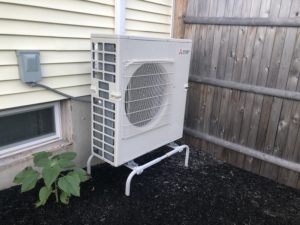Who is a member?
Our members are the local governments of Massachusetts and their elected and appointed leadership.

Net-zero energy codes encourage the use of electric heat pumps rather than burning fossil fuels.
On June 27, the Department of Energy Resources released draft language for its Base Energy Code, Stretch Energy Code and Specialized Municipal Opt-in Code.
The “stretch code” is an above-code appendix to the state’s base building energy code, designed to result in cost-effective construction that is more energy-efficient than what is built under the base code. Since 2010, municipalities have had two options: the base energy code or the stretch energy code. This past spring, through a Building Energy Code Straw Proposal, the DOER offered draft language for a new third option, the specialized municipal opt-in code.
The Climate Act of 2021 and the Green Communities Act of 2008 tasked the DOER with updating and implementing new energy code language by the end of this year.
Updating the stretch energy code is a technical method to help Massachusetts achieve its goal of net-zero emissions by 2050. With 299 cities and towns having adopted the existing stretch energy code and fulfilling other requirements for becoming a Green Community, the updated base, stretch, and specialized opt-in codes are expected to further advance clean and renewable energy practices.
The new code language would update compliance pathways in the base and stretch energy code and introduce more stringent energy efficiency requirements.
The base energy code is being refreshed with the 10th edition of Board of Building Regulations and Standards codes and the 2021 edition International Energy Conservation Code updates. The stretch energy code will similarly be updated with IECC 2021, updated Massachusetts code compliance pathways, and the elimination of some existing base code exceptions to further promote energy efficiency measures.
Specialized opt-in code
The DOER’s draft language would further define the new Specialized Opt-in Code, which would allow cities and towns that wish to adopt stricter local building codes to go beyond the base and stretch code by requiring all new buildings to be designed for electric service and wiring appropriate for future electrification.
The specialized code provides a set of net-zero building performance standards that combine highly energy-efficient design, onsite renewable energy generation, and electrification to comply with state emission limits and goals. The specialized opt-in stretch code language includes the following updated definition of a net-zero building: “A building which is consistent with achievement of MA 2050 net-zero emissions, through a combination of highly energy efficient design together with being an all-electric or Zero Energy Building, or, where fossil fuels are utilized, a building fully pre-wired for future electrification and that generates solar power on-site from the available Potential Solar Zone Area.”
The DOER has outlined the process by which cities and towns may pursue adoption of the specialized code. Adoption would require a vote by the city council or town meeting to opt-in, followed by a phase-in period to allow an appropriate transition for developers, designers, builders and code officials to get up to speed with new requirements. The specialized, net-zero requirements would take effect on the next Jan. 1 or July 1, whichever is at least six months after the municipal vote.
An increasing number of cities and towns are actively seeking the authority to prohibit on-site fossil fuel combustion in new construction and major renovations. Adoption of the specialized stretch energy code would be a meaningful move forward in efforts to reduce dependency on fossil fuels.
As the summary of the draft regulations acknowledges, “buildings reliant on fossil fuel combustion equipment have no clear path to zero emissions.” The updates to the base energy code, stretch energy code, and new specialized code target municipal priorities: emissions reduction within the buildings sector and increased energy efficiency across municipal, residential and commercial properties.
In March, the MMA submitted a letter during the Building Energy Code Straw Proposal public comment period highlighting issues of municipal concern regarding the proposal and its goals to address climate change through the energy code. The letter requested more details on the opt-in stretch energy code, including a strong definition of net-zero, as the straw proposal’s definition did not make reference to specific features of net-zero building performance that might be considered.
Next steps
The DOER has opened its public comment period on the new draft code language. Written comments can be submitted to stretchcode@mass.gov with the subject line “Building Code Comments” through 5 p.m. on Aug. 12.
Three public hearings are planned for July and August. An introductory webinar was held on July 7 that provided an overview of the updates and answered initial questions. Representatives from DOER gave context to the technical requirements of the new and updated energy efficiency pathways municipalities can follow to comply with the code language.
More information on the draft code language and upcoming events can be found on the Stretch Energy Code Development 2022 website.